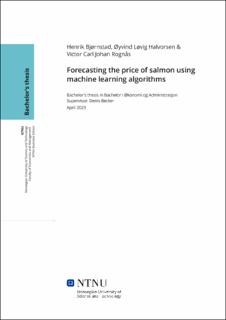| dc.contributor.advisor | Becker, Denis | |
| dc.contributor.author | Bjørnstad, Henrik | |
| dc.contributor.author | Halvorsen, Øyvind Løvig | |
| dc.contributor.author | Rognås, Victor Carl Johan | |
| dc.date.accessioned | 2023-06-14T17:20:13Z | |
| dc.date.available | 2023-06-14T17:20:13Z | |
| dc.date.issued | 2023 | |
| dc.identifier | no.ntnu:inspera:140915232:146857240 | |
| dc.identifier.uri | https://hdl.handle.net/11250/3071433 | |
| dc.description.abstract | Formålet med denne oppgaven er å bruke analytiske modeller til å predikere lakesprisen ved hjelp av lignende råvarer og økonomiske faktorer. For å produsere disse prediksjonene har vi brukt torskeprisen, kveiteprisen, KPI og TWI. Vi har utviklet fire modeller; ARIMA, SARIMA, SARIMAX og LSTM. Disse er alle trent på et datasett samlet inn fra Norsk Råfisklag, Norges Bank, Fishpool og SSB. Modellene er trent på data fra tidsperioden vår 2013 til vinter 2021, og testet på data fra 2022.
Vår forskning og testing har vist at prediksjonene forbedres når sesongvariasjon tas i betraktning. Forbedringen fra ARIMA- til SARIMA-modellen er vesentlig, mens forbedringen fra SARIMA til SARIMAX med én eksogen variabel er veldig liten. Dette vises også tydelig i prediksjonene fra de tre modellene, der SARIMA og SARIMAX omtrent følger de samme trendene, mens ARIMA predikerer den samme gjennomsnittsprisen for alle uker. Den beste prediksjonen fra LSTM-modellen er også nærme RMSE'en til SARIMAX-modellen, men resultatene fra LSTM-modellen varierer stort avhengig av "lookback"-perioden. "Lookback" på 52 og 104 uker er best på å fange trendene, men "lookback"-periodene for LSTM med lavest RMSE er tilfeldig. Med kort "lookback"-periode predikeres gjennomsnittet relativt bra. Dette resulterer i lav RMSE, men ved å se på grafene er det tydelig at dette ikke representeterer en god prediksjon.
Selv om SARIMAX-modellen presterer best, er det fortsatt områder med usikkerhet. Tester på SARIMAX-modellen viser at vi ikke kan konkludere med om residualene er støy. Den eneste konklusjonen vi kan trekke er at vi ikke kan forkaste nullhypotesen om at residualene er støy.
Konklusjonen fra denne oppgaven er at modellene som tar høyde for sesongvariasjon til en viss grad klarer å følge trendene, men de klarer ikke å predikere lakseprisen med høy nøyaktighet. | |
| dc.description.abstract | The purpose of this thesis is to utilize analytical models to predict the price of salmon using similar commodities and macroeconomic factors. To make these predictions we have used the cod price, halibut price, CPI and TWI. We have developed four models; ARIMA, SARIMA, SARIMAX and LSTM. These are all trained on a dataset gathered from Norsk Råfisklag. The models are trained on the data from the timeperiod spring 2013 to winter 2021, and tested on data from 2022.
Our research and testing has shown that the predictions improve when taking seasonality into account. The improvement from the ARIMA to the SARIMA model is very significant, whereas the improvement from SARIMA to the SARIMAX with one exogenous variable is very small. This is also clearly shown in the predictions from the three models, where the SARIMA and SARIMAX roughly follow the same trends, and the ARIMA simply predicts the same average price for all weeks. The best prediction from the LSTM model also comes close to the RMSE of the SARIMAX model, but the results from the LSTM model varies greatly depending on the lookback period. Lookbacks of 52 and 104 weeks are the best perfoming in terms of catching the trends, but the lookback periods of the models with the lowest RMSE is quite random. LSTM with short lookback periods predict the average quite well, meaning that the RMSE is low, however, when looking at the graphs its clear that this does not actually represent a good prediction.
Even though the SARIMAX model performs the best, there are still areas of uncertainty. Tests on the SARIMAX model show that we can't conclude whether or not the residuals are white noise. We can only conclude that we can't reject the null hypothesis that the residuals are white noise.
In conclusion the models taking seasonality into account can to some extent catch the trends in the price of salmon, but they are not able to predict the price of salmon with a high degree of accuracy. | |
| dc.language | eng | |
| dc.publisher | NTNU | |
| dc.title | Forecasting the price of salmon using machine learning algorithms | |
| dc.type | Bachelor thesis | |
